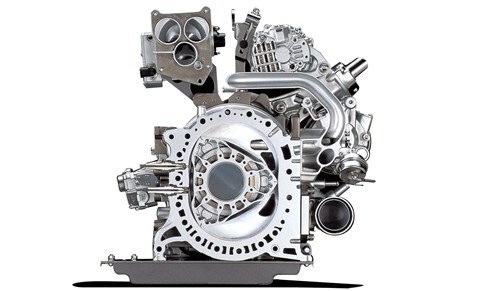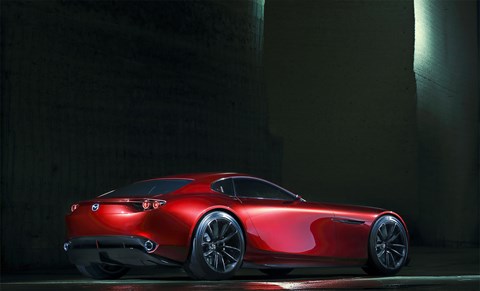► Mazda plan to revive the RX-7
► CAR takes a closer look at the concept
► Rotary reborn, and manual only
Based on their showings at the recent Tokyo motor show, Honda – rightly or wrongly – is convinced the future is fuel-cell powered. Over at Nissan, Carlos Ghosn is on a path to autonomous electric mobility via cash-rich funky crossovers. In stark contrast Mazda has gazed at 2018 and seen this: an analogue sports car notable for all that it lacks (a hybrid powertrain, autonomous tech, a neon-lit, tablet-stuffed ‘lounge’ interior) as the things that it has: fossil-fuelled rotary engine, rear-wheel drive, a manual gearbox and a striking, unfussy beauty.
‘This car is the embodiment of Mazda’s future vision: the ultimate front-engined, rear-wheel-drive sports car,’ said CEO Masamichi Kogai as he pulled the covers from the RX-Vision and the world bit its collective fist in lust. ‘It is driving pleasure with excellent environmental performance. The rotary engine has not been an easy path but one day the rotary will make a comeback. There are many issues to overcome but we won’t stop working.’
Mazda insists RX-Vision is a concept car in the truest sense, and that a production-ready RX-7 does not lurk in the wings. ‘I can tell you that a production car does not exist: this is a pure design concept,’ says veteran Mazda designer Ikuo Maeda, whose team created RX-Vision’s endless bonnet, fuss-free surfaces and restrained, almost classical detailing. ‘This is a pure design exercise, though I hope this is a car with which we can go head-to-head with Porsche. It is our aspiration to take our brand to the next level. I hope we have enough strong voices to dictate that we do that with this car.’
The concept sits on a unique platform and carries its compact rotary motor low and tight against the front bulkhead. At 4389mm by 1925mm and 1160mm, the two-seater comes in shorter, wider and lower than a 991 Porsche 911. ‘The concept is on the larger side, but the ideal would be lightweight sports car with a very taut design,’ continues Maeda. ‘There are a number of potential materials, including carbonfibre and aluminium – Mazda has the technology to exploit aluminium. If you consider the price and engine performance [£49k and 321bhp for the 3.4 S] then perhaps the Cayman is an appropriate comparison.’
It’s a sentiment echoed by r&d boss Kiyoshi Fujiwara. ‘If we mass-produce this car then we would make it lighter than a Cayman. We made the MX-5 a very light car. We’d do the same with this rotary.’
All of which bodes well for a production coupe (and convertible) with the RX-Vision’s styling and the RX-7 name. Fujiwara: ‘In the past RX-7 was always a two-seater or a 2+2. RX-8 was a four-seater. If we call it RX-9 – six-seater? You can imagine this car’s name.’ Strengthening the case for a next-gen RX-7 was the reaction to the car in Tokyo: Mazda held sway over the kind of new-product hysteria normally reserved for a new iPhone. As for the timescale, while a 2017 release would make for a neat anniversary launch – the original Cosmo rotary debuted in 1967 – Mazda will have its work cut out to get the car ready. Alfa’s crack team may have created the new Giulia in two years but they didn’t have the rotary engine to contend with.
Fond of burning fuel, slurping oil and merrily parping all sorts of filth from its exhausts, the Wankel has caused Mazda no small amount of grief. It won Le Mans for them of course, and the third-generation RX-7 FD is rightly regarded as one of Japan’s great sport cars but, as engineer Fujiwara points out, the rotary’s also been challenging. ‘We have a solution now for the problems but we need to be sure it is durable. We want to do two or three times more testing than we do normally, because we have this past experience of quality problems and causing such inconvenience to our customers.’
Why bother, you wonder? While there are advantages in the rotary’s strong output for a given size and weight, and the type’s intrinsic smoothness, you get the feeling that, perhaps commendably, at Mazda heart is ruling head.
Maeda: ‘I owned one of the first RX-7s and a third-generation RX-7 FD, my favourite. We feel that if we drop the rotary the technology will disappear from the world. For that reason we have the mindset to cherish it. We would dearly like to race with it again too, and if we do I’d like to be behind the wheel!’
The RX-Vision’s beguiling form, weighing next to nothing, badged RX-7 and howling onto our roads just as a race version makes a triumphant return to Le Mans in the 2018 24 Hours? Sounds like a future worth striving for.
Mazda’s plan to save the rotary

> The pros: Powerful for a given size, smooth and lightweight.
> The cons: Sealing the rotor unit is notoriously difficult – gases leak past the rotor tips, saddling the car with dirty exhaust emissions and poor fuel economy.
> The fix: Mazda’s developed its own technology to be able to observe the combustion process within the engine, something manufacturers have done for years in order to hone the conventional piston engine to near-perfection. Mazda is feeding this information into computer analysis to yield improvements in exhaust gas quality and fuel economy. It’s also working on those all-important rotor seals, and seeking to boost torque – another rotary weakness – through ignition timing.
> The other options: Hybrid technology has previously been hailed as the rotary’s saviour (Audi dabbled with the idea on the 2011 A1 E-tron concept) but Mazda’s Fujiwara says, ‘We are not currently working on a hybrid rotary.’ Turbocharging, as employed on the FD RX-7 and Le Mans-winning 787B, is a safer bet.
Mazda RX7: broken down
No distractions
Designer Maeda: ‘We reduced the number of elements to the minimum. There is just the saddle leather and a couple of simple dials and controls – no distractions’
Rotary here please
Compact rotary engine sits well aft of the front axle, effectively making the RX mid-engined. Remainder of enormous bonnet presumably conceals several spare wheels and a stowaway
There will be light
MX-5 is proof of Mazda’s love of small, lightweight cars made of aluminium. RX-Vision will shrink in its transition to road-ready, Porsche Cayman-baiting RX-7

Manual and rwd
No NSX-style fancy all-wheel drive, just driven rear wheels and a manual ’box, though Mazda acknowledges buyers may demand a nice and easy DCT
Look, no creases
Vast, organic flanks designer Maeda’s favourite bit – ‘Much of this design is adaptable for future products’. Good news
Adjustable aero
Rear end dominated by twin exhausts, adjustable rear wing and a prominent diffuser promising downforce, but the body was shaped for style first, aero second